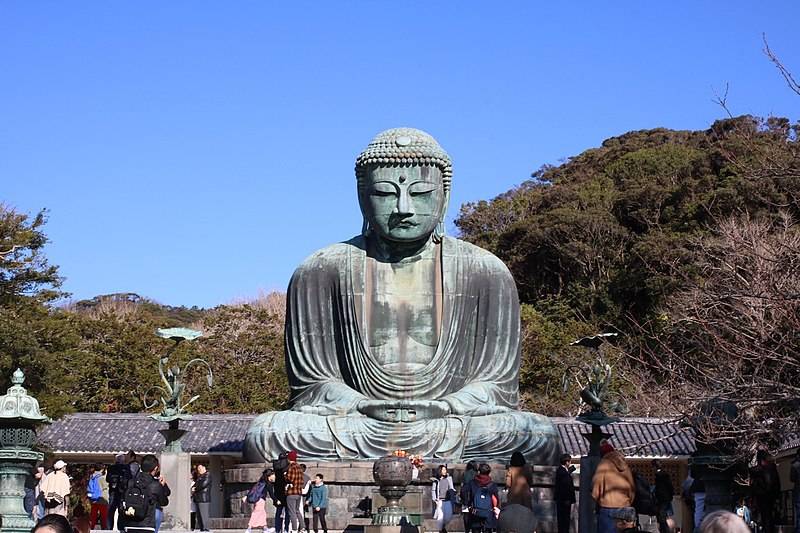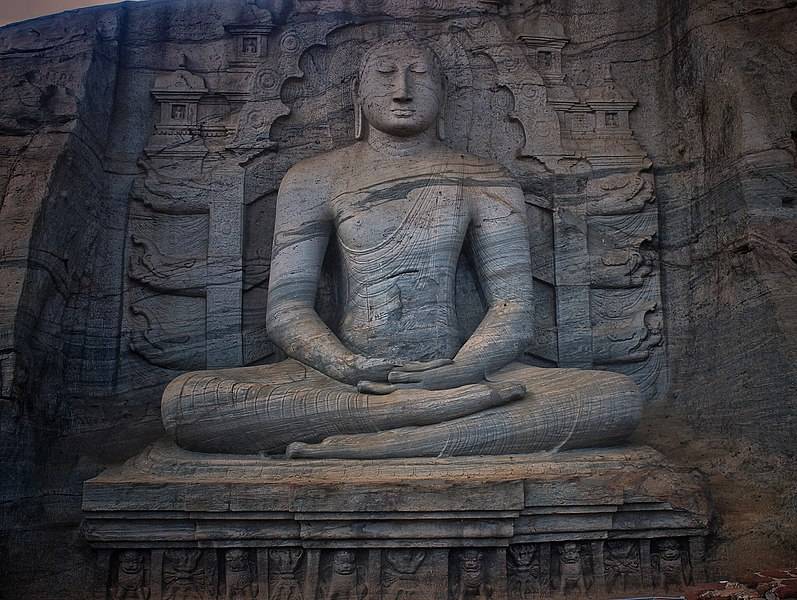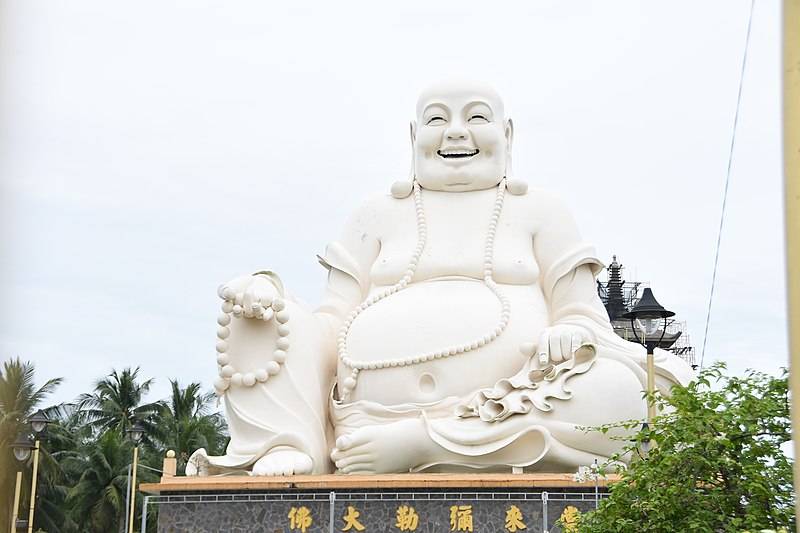One of Buddha’s fundamental insights was that of Pratītyasamutpāda (Sanskrit: प्रतीत्यसमुत्पाद, Pāli: paṭiccasamuppāda). This states that all phenomena arise from other previous phenomena. All that we observe arises from preceding causes. This insight extends in the Four Noble Truths to explain karma and samsara.
We can use the insight of arising phenomena to gain insight about ourselves using a feature common across Asia. Let us reflect on a few of the numerous beautiful Buddha statues built throughout the lands.

WeelStone, CC BY-SA 3.0, via Wikimedia Commons

QUICPay, CC BY-SA 4.0, via Wikimedia Commons

fannyss, CC0, via Wikimedia Commons

Buddhika0725, CC BY-SA 4.0, via Wikimedia Commons

Shankar S, CC BY 2.0, via Wikimedia Commons

Christophe95, CC BY-SA 4.0, via Wikimedia Commons
What do we observe from these statues, these beautiful works of art, whether of stone sculpture or bronze metalwork?
Reflections on the Diversity of Buddha Statues
Their great size and longevity show that they were built with great engineering knowledge and metallurgical skill. Those who crafted these statues were both engineers with technical know-how as well as artists.
We also see that Buddha statues, through their mudras, or hand gestures, convey symbolic messages. The artists and craftsmen who built the statues inscribed messages to those admiring these works. Those who come to admire Buddha statues receive and understand these mudras. Both the builders and the viewers have an innate capacity, an instinct even, to send and receive messages using symbols.

We also observe that their artistic beauty attracts people from all over the world simply to view and admire them. Those of us who did not make these statues nonetheless find them attractive. Some come just to admire the artistic and technical achievements, while others meditate on the meaning of the mudras.
Some come also for religious veneration. Since these statues represent the Buddha, they evoke reverence and awe, even in those who are not followers of Buddha.
Cause Questions About Mankind…
We observe all this in the statues themselves, in watching others who come to admire them, and even in ourselves. The Pratītyasamutpāda insight, all phenomena arise from preceding ones, begs the question: Where do the following phenomena come from?
- The instinct in humans to both create art (Buddha statues) and also to value art (we who venerate them).
- The human ability to focus on to crafting structures (these statues) requiring technical understanding, for a specific purpose.
- The inborn ability to understand, send, and receive symbolic messages as seen in the mudras of these statues.
- The innate ability for these statues to evoke reverence in the heart, soul and mind of many of the devotees.
What preceding causes were within people such that these phenomena are consistently displayed? This is true across all cultures, throughout history, around the world, between the sexes, and in all languages. Humans consistently display these (and similar) characteristics. These go beyond trying merely to survive or avoid suffering. In the West, explanations grounded in natural evolutionary processes have difficulty in explaining artistic and mystical qualities in people. In the East, explanations grounded solely in ignorance due to attachments similarly have difficulty in explaining these qualities.
…Answered From the Ancient Hebrew Scriptures
Some of the most ancient writings in the world offers a simple explanation for these observed human characteristics. They explain why you are here and for what purpose. They were written at the beginning of human history in a language more ancient than both Pali and Sanskrit. Their origins rival the Chinese language in terms of age. A unique people, the Hebrews, produced and preserved these writings, together forming an epic story.
This collection of writings have been grouped together into one recognizable book commonly called the Bible. How does the Bible begin its epic? How does it shed light on who you are? The Bible starts simply with:
1 In the beginning, God created the heavens and the earth.
Genesis 1:1
A few sentences later, the Bible states:
26 Then God said, “Let us make mankind in our image, in our likeness, so that they may rule over the fish in the sea and the birds in the sky, over the livestock and all the wild animals, and over all the creatures that move along the ground.”
27 God created mankind in his own image;
Genesis 1:26-27
in the image of God he created them;
male and female he created them.
“In the Image of God”
What does it mean that the Creator God created mankind ‘in the image of God’? It does not mean that God is a physical being with two arms, a head, etc. Rather, at a deeper level, it means that basic characteristics of people arise from similar characteristics of God. In short, it applies the principle of Pratītyasamutpāda onto us. So, for example, both the Creator God (in the Bible) and people (from observation) have intellect, emotions, and will. The Bible portrays God as sad, hurt, angry, or joyful – the same range of emotions that we as humans experience. We make choices and decisions on a daily basis. Similarly, God in the Bible makes choices and comes to decisions. Our ability to reason and think abstractly comes from God. We have the capabilities of intellect, emotion, and will, because God has them, and He created us in His image.

Without any difficulty we perceive that we are sentient beings, both self-aware and conscious of ‘I’ and ‘you’. We are not impersonal ‘its’. The Bible teaches that we are like this because God is Person and we are made in His image.
The Arising of the Artist in Us
We also innately create and appreciate art, like the aforementioned statues of Buddha. People naturally appreciate and even need beauty. Similarly to how we admire art in statues, we also admire our beautiful world, whether majestic mountains, stirring sunsets, or lotus colors. The Bible declares that God, as Creator of the world, made the mountains, the sun to set, and the lotus. He made them to function, but also as beautiful art. We appreciate this art because we are made in God’s image. We also create art, like Buddha statues, because we naturally have the capabilities that He has, as a result of being created in His image. This goes beyond just visual art, including music and literature, among other art forms. Think about how important music is to us – or even our love of dance. Music enriches our lives. We love good stories, whether in novels or plays, or more commonly today, in movies. Stories have heroes, villains, drama, and great stories burn these heroes, villains, and drama into our imaginations. Thus, it is natural for us to use and appreciate art in its many forms. We entertain, reinvigorate, and refresh ourselves with art because God is an Artist and we are in his image.
It is a question worth asking. Why are we naturally aesthetic, whether in art, drama, music, dance, or literature? Daniel Dennett, an outspoken atheist and an authority on understanding cognitive processes, answers from a materialistic perspective:
“But most of this research still takes music for granted. It seldom asks: Why does music exist? There is a short answer, and it is true, so far as it goes: it exists because we love it and hence we keep bringing more of it into existence. But why do we love it? Because we find that it is beautiful. But why is it beautiful to us? This is a perfectly good biological question, but it does not yet have a good answer.”
Daniel Dennett. 2006. Breaking the Spell: Religion as a Natural Phenomenon. p. 43
The materialistic perspective on mankind has no answer to this fundamental question about human nature. From the Biblical perspective, it is because God is artistic and aesthetic. He made things beautiful and enjoys beauty. You, made in His image, are the same.
The Beauty in Mathematics
Closely linked to aesthetic beauty is mathematics. Patterns from geometric ratios give rise to fractals and other shapes that we find beautiful and mathematically elegant. Watch this video explain the elegance of the Mandelbrot Set, and ask the question of why abstract concepts, such as numbers, seem to govern the behaviour of the universe, and why we appreciate their beauty.
Why We Are Moral
In addition, being ‘made in God’s image’ explains our natural moral capacity so common across all cultures. We see this clearly in the moral wisdom of the Noble Eight-Fold Path. The Creator God is deeply concerned about goodness and fairness. Thus, similar to a compass aligned to magnetic North, our alignment to ‘fair’, ‘good’, and ‘right’ follows His alignment. It is not just religious people who are made in this way – everyone is. Not recognizing this can give rise to misunderstandings. Take for example this challenge from the materialist American Sam Harris.
“If you are right to believe that religious faith offers the only real basis for morality, then atheists should be less moral than believers.”
Sam Harris. 2005. Letter to a Christian Nation. p. 38-39
Harris is simply wrong here. Our sense of morality comes from God’s image in us, not from being religious. This is why atheists, like all the rest of us, have this moral sense and can act morally. The difficulty with atheism is to account for why we have our morality. However being created according to God’s moral image provides a simple and straightforward explanation.
Why We Are Relational
Biblically, the starting point to knowing ourselves comes from recognizing our status as God’s image bearers. Therefore, gaining insight into either God (through the Bible) or people (through observation) also gives insight into the other. For example, consider the importance people place on relationships. Seeing a good movie is fine, but it is a much better experience to see it with a friend or family member. We naturally seek out peers to share experiences with. Meaningful friendships and family relationships are key to our sense of well-being. Conversely, loneliness and/or fractured family relationships and breakdowns in friendships tend to stress us. We are not neutral and unmoved by the state of relationships we have with others. A reason as to why Bollywood movies are so popular is because they emphasize the relationships between characters (between lovers, family members etc.).

Creator God is Love
Now, if we are in God’s image, then we would expect to find this same relational emphasis with God. In fact we do. The Bible says that:
8 …God is love.
1 John 4:8
The Bible teaches much about the importance that God places on our love for Him and our love for others. In fact, Jesus teaches that strengthening these two relationships are the two most important commands in the Bible. When you think about it, love must be relational, as it requires someone who loves (the lover), and another who is the object of this love (the beloved).
Thus we should think of The Creator God as a Lover. If we only think of Him as the ‘Prime Mover’, the ‘First Cause’, the ‘Omniscient Deity’, the ‘Benevolent Being’, or perhaps the ‘Buddha Consciousness’, we are not thinking of the Biblical God. Though He is these aforementioned titles, The Bible portrays Him as almost recklessly passionate in relationship. He does not ‘have’ love, bur rather, He ‘is’ love. The two most prominent Biblical images of God’s relationship with people are that of a father to his children and a husband to his wife. Those are not dispassionately philosophical ‘first cause’ analogies, bur rather the deepest and most intimate of human relationships.
Building on the Hebrew Foundation

So here is the foundation we have laid so far. People are made in God’s image comprised of mind, emotions, and will. We are sentient and self-aware. People are moral beings with our ‘moral grammar’ giving us an innate orientation of ‘right’ and ‘fair’. We have instinctive capability to develop and appreciate beauty, drama, art, and story in all its forms. We also naturally seek out and develop relationships with others. You possess these traits because God embodies them, and you have been created in His image.
Buddha statues are of great worth and interest because they portray an image of the Buddha. The intrinsic value of an image derives from what the image consists of. An image of an orange is not of much value because of its commonality, but people venerate images of the Buddha because the Buddha himself was unique and treasured. Thus, Buddha statues carry greater value than statues of other people because the Buddha is intrinsically more precious than others.

An Orange is a common commodity so no one takes the time to make images of it. Dietmar Rabich / Wikimedia Commons /

The Buddha was unique and special so the images of Buddha are valuable and even sacred. Photo: Joydeep / Wikimedia Commons
In the same way, because you are in God’s image (and not in some other image) you are immensely valuable. You carry worth and dignity regardless of your wealth, age, education, social status, language, and gender, simply because you are ‘in the image of God’. God knows this and He wants you to realize this as well.
But if this is so, why is the world, both yours and mine, full of endless cycles of suffering and death? The Biblical story continues on to explain how this arose.